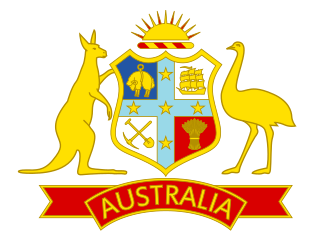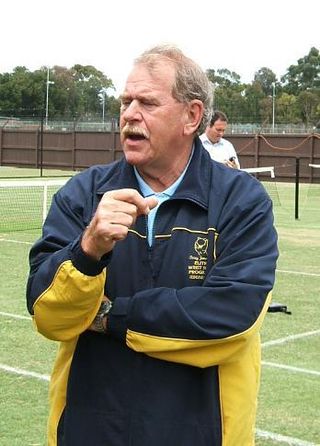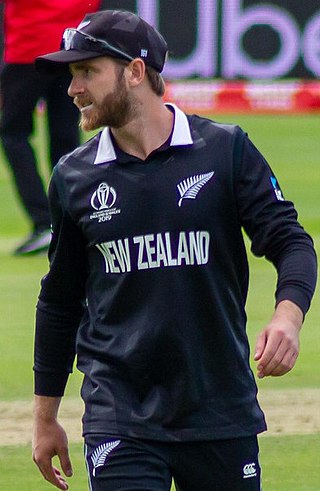Related Research Articles

Michael Andrew Atherton is a broadcaster, journalist and a former England international cricketer. A right-handed opening batsman for Lancashire and England, and occasional leg-break bowler, he achieved the captaincy of England at the age of 25 and led the side in a then record 54 Test matches. Known for his stubborn resistance during an era of hostile fast bowling, Atherton was described in 2001 as a determined defensive opener who made "batting look like trench warfare". He had several famed bouts with bowlers including South Africa's Allan Donald and Australia's Glenn McGrath. Atherton often played the anchor role at a time when England batting performances lacked consistency.

The Australia men's national cricket team represents Australia in men's international cricket. As the joint oldest team in Test cricket history, playing in the first ever Test match in 1877, the team also plays One-Day International (ODI) and Twenty20 International (T20I) cricket, participating in both the first ODI, against England in the 1970–71 season and the first T20I, against New Zealand in the 2004–05 season, winning both games. The team draws its players from teams playing in the Australian domestic competitions – the Sheffield Shield, the Australian domestic limited-overs cricket tournament and the Big Bash League. Australia are the current ICC World Test Championship and ICC Cricket World Cup champions. They are regarded as most successful cricket teams in the history of Cricket.

In cricket, the stumps are the three vertical posts that support the bails and form the wicket. Stumping or being stumped is a method of dismissing a batsman.
Ian David Stockley Smith is a New Zealand cricket and rugby commentator and former cricketer. He played as a wicket-keeper for New Zealand throughout the 1980s and part of the 1990s.
Obstructing the field is one of the ten methods of dismissing a batsman in the sport of cricket. Either batsman can be given out if he wilfully attempts to obstruct or distract the fielding side by word or action. It is Law 37 of the Laws of cricket, and is a rare way for a batsman to be dismissed; in the history of cricket, there has been only two instances in Test matches, nine in One Day International (ODI) matches, and six in Twenty20 International matches. There have also been seven instances in Test cricket, and two in ODIs, where a batsman has been dismissed handled the ball, a mode of dismissal now folded into obstructing the field.
Runako Shakur Morton was a Nevisian cricketer who played for West Indies in all formats of the game. He was a right-handed batsman and a right-handed offbreak bowler.
In cricket, a duck is a batsman's dismissal with a score of zero. A batsman being dismissed off their first delivery faced is known as a golden duck.
Deshabandu Handunnettige Deepthi Priyantha Kumar Dharmasena is a Sri Lankan cricket umpire and former international cricketer. He is a member of the Elite Panel of ICC Umpires and the first person to participate in an ICC Cricket World Cup final both as a player and an umpire. A right-handed batsman and a right-arm off break bowler, Dharmasena was a member of the Sri Lankan side that won the 1996 Cricket World Cup.

Terrence James Jenner was an Australian cricketer who played nine Tests and one ODI from 1970 to 1975. He was primarily a leg-spin bowler and was known for his attacking, loopy style of bowling, but he was also a handy lower-order batsman. In his latter years he was a leg-spin coach to many players around the world, and a great influence on Shane Warne. He was also a radio cricket commentator for the Australian Broadcasting Corporation.
A pair in cricket refers to when a batsman is dismissed for a duck in both innings. It is called a 'king pair' if the batsman gets out for a golden duck in both innings.
Tom Kerr was a British comic strip artist whose work has appeared in comics such as Look-in, the Eagle, Valiant, and TV21. He has also drawn for many annuals of the 1960s and 1970s, including the Monkees annuals, Look-in annuals, etc. He is not to be conflated with the Australian cartoonist of the same name, who was responsible for such creations as Daddles, an animated duck that would walk along the TV screen when a cricketer scored a duck.

Kane Stuart Williamson is a New Zealand international cricketer and a former captain of the New Zealand national team. On 27 February 2023, Williamson became the all-time leading run-scorer for New Zealand in Test cricket. A right-handed batsman and an occasional off spin bowler, he is widely regarded as one of the greatest contemporary batsmen and captains New Zealand has ever produced and the greatest New Zealand batsman of all time. He captained New Zealand to victory in the 2021 ICC World Test Championship final and to the finals of the 2019 Cricket World Cup and 2021 T20 World Cup. He was also a part of the New Zealand squad to finish as runners-up at the 2015 Cricket World Cup.
Dean Graham Brownlie is an Australian-born international New Zealand cricketer, currently playing for the Northern Districts cricket team in New Zealand domestic cricket. He has represented the New Zealand national cricket team in all three formats, qualifying to represent the team by way of his father's birthplace.

Deshabandu Pinnaduwage Aravinda de Silva is a former Sri Lankan cricketer and captain, Regarded as one of the best Sri Lankan cricketers, he played in the team as an all-rounder. De Silva was a key member of the Sri Lankan team that won 1996 Cricket World Cup, where he scored a match winning century in the final, that brought Sri Lanka from underdog status to present-day form. He has held various posts in Sri Lankan Cricket after his retirement in 2003. He was inducted into ICC Cricket Hall of Fame in 2023.
The New Zealand cricket team toured Australia from 18 November – 13 December 2011. The tour consisted of two Tests played for the Trans-Tasman Trophy.
The New Zealand cricket team toured Australia from 23 October to 1 December 2015 to play three Test matches and four tour matches. The third match of the series at the Adelaide Oval was the first ever day-night Test. Michael Hussey captained the Prime Minister's XI side for the tour match, and in preparation for the day-night Test, a pink ball was used in this game. Australia won the series 2–0, with victories in Brisbane and Adelaide, with the second Test in Perth being drawn.
Wedagedara Sadeera Rashen Samarawickrama, popularly as Sadeera Samarawickrama, is a professional Sri Lankan cricketer who represents the national team in all formats of the game. He was part of Sri Lanka's squad for the 2014 ICC Under-19 Cricket World Cup. He is a past pupil of Thurstan College and St. Josephs College, Colombo,Sri Lanka.

Muthuthanthrige Vishwa Thilina Fernando, commonly as Vishwa Fernando, is a professional Sri Lankan cricketer, who represents the national side in all three formats. He had his education in St. Sebastian's College, Moratuwa. He is the elder brother of the emerging cricketer Nuwanidu Fernando.
The New Zealand cricket team toured Australia in December 2016 to play three One Day Internationals (ODIs) matches. The matches were played for the Chappell–Hadlee Trophy.
The West Indies cricket team toured New Zealand in December 2017 and January 2018 to play two Tests, three One Day Internationals (ODIs) and three Twenty20 International (T20I) matches. Three Tests were originally planned, but it was reduced to two by New Zealand Cricket (NZC) to conform to the expected tour make-up when the ICC World Test Championship is implemented. Ahead of the Test series, a three-day tour match was planned, which started on 25 November 2017.
References
- ↑ Buckland, William (2008). Pommies: England Cricket Through an Australian Lens . Matador. p. 85. ISBN 978-1-906510-32-9 . Retrieved 25 May 2011.
daddles the duck.
- 1 2 Cahill, Damian. "Australian Rules Cricket". Transdiffusion Broadcasting System. Archived from the original on 9 June 2011. Retrieved 25 May 2011.
- ↑ Williamson, Martin (7 June 2007). "Hawk-Eye, hotspots and Daddles the Duck". Cricinfo . Retrieved 25 May 2011.
- ↑ Batsman walking off with daddles the duck , retrieved 20 August 2022
- ↑ Soni, Paresh (27 December 2005). "Cricket revolution". BBC Sport. Retrieved 25 May 2011.
- ↑ Williamson, Martin (13 December 2007). "Cameras, lights and coral pink | Regulars | Cricinfo Magazine". Cricinfo . Retrieved 25 May 2011.
- 1 2 Browning, Mark (1 October 2003). Rod Marsh: A Life in Cricket. p. 209. ISBN 1-877058-23-8 . Retrieved 25 May 2011.
- ↑ Rampton, James (26 June 1999). "Just not cricket?". The Independent . Retrieved 25 May 2011.
- ↑ Walsh, Scott (6 December 2009). "Can we save Test cricket?". Adelaide Now. Retrieved 25 May 2011.
- ↑ "Daddles the Duck". KerrToons. Retrieved 20 August 2022.
